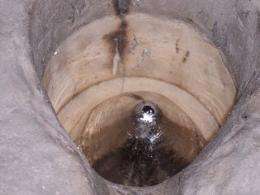A miracle diet for brake rotors: High-strength, high-temp aluminum

Weight loss is a big fat deal in America, and not just for people. Auto manufacturers are always looking for ways to shave a few pounds off their cars and trucks. Just as losing weight can improve your health, slimming down your vehicle can lighten its appetite for fuel, which is good for both your wallet and the environment.
Despite manufacturers' best efforts, some parts have remained persistently porky. Among them are brake rotors, those cast iron discs that make you stop when you hit the brakes.
If you could make rotors out of aluminum, says Paul Sanders, the average car would lose about 50 pounds. “That’s a big number on a car,” says Sanders, an assistant professor of materials science and engineering at Michigan Technological University. “Every 10 percent saved in weight on a vehicle equals roughly 4 percent in fuel economy. You could save 0.8 percent in fuel. It doesn’t sound like much, but it can be huge for the fleet.”
Manufacturers haven’t made the switch because aluminum starts losing strength at relatively low temperatures, 250 degrees Celsius (about 480 degrees Fahrenheit). “If you had aluminum brakes, driving down Pike’s Peak would do you in,” Sanders says. “We wanted to design aluminum alloys which maintain their strength up to 400 degrees.”
To do that, Sanders and his team of graduate students and undergraduates are using different elements in making the aluminum alloy. Traditionally, silicon, copper and magnesium are added to aluminum to improve its properties. Sanders is replacing them with minute quantities of an exotic blend of zirconium and rare earths, including scandium.
So far, his strategy is working: the hardness of the new alloy peaks at the magic 400 degrees. Now, the team is preparing to run tensile tests on the metal in cooperation with students from Northwestern University, where Sanders earned his PhD. “We suspect that it will be good in both areas—strong and stretchy,” said Sanders. “Typically, materials are good in one but not the other.”
A high-strength, high-temp aluminum might also replace iron and steel parts in turbochargers, which can get up to 500 degrees and hotter. And it could supplant the standard aluminum alloy used in most pistons. As engines get more efficient, they generate so much heat that pistons made with conventional aluminum have to be sprayed with oil to prevent overheating and strength loss . “We could replace that entire mechanism, and we would like to collaborate with Tech’s mechanical engineering department to incorporate these new alloys in new engine designs ,” Sanders said.
The team is also experimenting with a variety of rare earths to replace the scandium, which has one disadvantage: it costs about $3,500 a kilogram.
It’s a welcome challenge. Sanders loves to fiddle around with materials, especially metals, and it’s hard to find a better place to do that than Tech. “We kept a lot of old-school metallurgy capabilities,” he says. “Most universities don’t have them anymore. We have tremendous space and can do things others can’t do in melting, casting, rolling of sheets, and more.”
In particular, the University still has a foundry. If the team needs to cast something, “all we need to do is go downstairs,” he said.
In 2009, Sanders left Ford Motor Company to join the faculty at Michigan Tech, where he had earned his bachelor’s in metallurgical and materials engineering. He still maintains close ties with his old employer; Ford is funding his aluminum research and hopes his investigations will eventually pay dividends in the form of lighter vehicles. With its facilities and students eager for hands-on experience, the University is providing an ideal matrix for that effort. “I’m in a better position to do my research here,” Sanders said. “Tech is an ideal place to make a difference.”
Provided by Michigan Technological University

















